Intraesophageal administration of GS-nitroxide (JP4-039) protects against ionizing irradiation-induced esophagitis
- PMID: 21164038
- PMCID: PMC3521523
Intraesophageal administration of GS-nitroxide (JP4-039) protects against ionizing irradiation-induced esophagitis
Abstract
Background/aim: this study evaluated esophageal radioprotection by the Gramicidin S (GS) derived-nitroxide, JP4-039, a mitochondrial targeting peptide-isostere covalently-linked to 4-amino-Tempo, delivered in a novel swallowed oil-based (F15) formulation.
Materials and methods: C57BL/6HNsd female mice received intraesophageal F15 formulation containing JP4-039 (4 mg/ml in 100 microl volumes) 10 minutes before 28 or 29 Gy upper body irradiation compared to MnSOD-PL (100 microl containing 100 microg plasmid) 24 hours prior to irradiation. Subgroups received 1 × 10(7) C57BL/6HNsd, GFP(+) male bone marrow cells intravenously 5 days after irradiation.
Results: JP4-039/F15 or MnSOD-PL increased survival compared to irradiated controls (p<0.0001 for either). Marrow injection further increased survival (p=0.0462 and 0.0351, respectively). Esophagi removed at 1, 3, 7, 14, 24, or 60 days showed bone marrow-derived cells in the esophagi.
Conclusion: intraesophageal GS-nitroxide radioprotection is mediated primarily through recovery of endogenous esophageal progenitor cells.
Figures
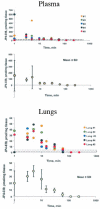
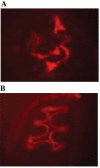
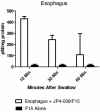
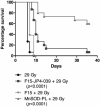
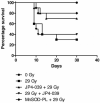
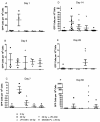
Similar articles
-
Amelioration of radiation esophagitis by orally administered p53/Mdm2/Mdm4 inhibitor (BEB55) or GS-nitroxide.In Vivo. 2011 Nov-Dec;25(6):841-8. In Vivo. 2011. PMID: 22021675 Free PMC article.
-
Esophageal radioprotection by swallowed JP4-039/F15 in thoracic-irradiated mice with transgenic lung tumors.In Vivo. 2014 Jul-Aug;28(4):435-40. In Vivo. 2014. PMID: 24982207 Free PMC article.
-
Amelioration of radiation-induced oral cavity mucositis and distant bone marrow suppression in fanconi anemia Fancd2-/- (FVB/N) mice by intraoral GS-nitroxide JP4-039.Radiat Res. 2014 Jul;182(1):35-49. doi: 10.1667/RR13633.1. Epub 2014 Jun 16. Radiat Res. 2014. PMID: 24932534 Free PMC article.
-
Intraesophageal MnSOD-plasmid liposome enhances engraftment and self-renewal of bone marrow derived progenitors of esophageal squamous epithelium.Gene Ther. 2008 Mar;15(5):347-56. doi: 10.1038/sj.gt.3303089. Epub 2007 Dec 20. Gene Ther. 2008. PMID: 18097469
-
Prevention of irradiation-induced esophagitis by plasmid/liposome delivery of the human manganese superoxide dismutase transgene.Radiat Oncol Investig. 1999;7(4):204-17. doi: 10.1002/(SICI)1520-6823(1999)7:4<204::AID-ROI2>3.0.CO;2-S. Radiat Oncol Investig. 1999. PMID: 10492161
Cited by
-
Amelioration of Mucositis in Proton Therapy of Fanconi Anemia Fanca-/- Mice by JP4-039.In Vivo. 2019 Nov-Dec;33(6):1757-1766. doi: 10.21873/invivo.11666. In Vivo. 2019. PMID: 31662500 Free PMC article.
-
Nanoassembly of surfactants with interfacial drug-interactive motifs as tailor-designed drug carriers.Mol Pharm. 2013 Jan 7;10(1):187-98. doi: 10.1021/mp300319m. Epub 2012 Dec 17. Mol Pharm. 2013. PMID: 23244299 Free PMC article.
-
Can Radiosensitivity Associated with Defects in DNA Repair be Overcome by Mitochondrial-Targeted Antioxidant Radioprotectors.Front Oncol. 2014 Feb 17;4:24. doi: 10.3389/fonc.2014.00024. eCollection 2014. Front Oncol. 2014. PMID: 24596683 Free PMC article.
-
Metabolic Rewiring in Radiation Oncology Toward Improving the Therapeutic Ratio.Front Oncol. 2021 May 10;11:653621. doi: 10.3389/fonc.2021.653621. eCollection 2021. Front Oncol. 2021. PMID: 34041023 Free PMC article. Review.
-
Strategies for discovery of small molecule radiation protectors and radiation mitigators.Front Oncol. 2012 Jan 13;1:59. doi: 10.3389/fonc.2011.00059. eCollection 2011. Front Oncol. 2012. PMID: 22655254 Free PMC article.
References
-
- Movsas B, Moughan J, Sarna L, Langer C, Werner-Wasik M, Nicolaou N, Komaki R, Machtay M, Wasserman T, Watkins Bruner D. Quality of life supersedes the classic prognosticators for long-term survival in locally advanced non-small cell lung cancer: An analysis of RTOG 9801. J Clin Oncol. 2009;27:5816–5821. - PMC - PubMed
-
- Patel AB, Edelman MJ, Kwok Y, Krasna MJ, Suntharalingam M. Predictors of acute esophagitis in patients with non-small cell lung carcinoma treated with concurrent chemotherapy and hyperfractionated radiotherapy followed by surgery. Int J Radiation Oncol Biol Phys. 2004;60:1106–1112. - PubMed
-
- Stickle RL, Epperly MW, Klein E, Bray JA, Greenberger JS. Prevention of irradiation-induced esophagitis by plasmid/liposome delivery of the human manganese superoxide dismutase (MnSOD) transgene. Radiat Oncol Invest Clinical Basic Res. 1999;7:204–217. - PubMed
-
- Epperly MW, Gretton JA, DeFilippi SJ, Sikora CA, Liggitt D, Koe G, Greenberger JS. Modulation of radiation-induced cytokine elevation associated with esophagitis and esophageal stricture by manganese superoxide dismutase-plasmid/liposome (MnSOD-PL) gene therapy. Radiat Res. 2001;155:2–14. - PubMed
-
- Epperly MW, Kagan VE, Sikora CA, Gretton JE, DeFilippi SJ, Bar-Sagi D, Greenberger JS. Manganese superoxide dismutase-plasmid/liposome (MnSOD-PL) administration protects mice from esophagitis associated with fractionated irradiation. Int J Cancer (Radiat Oncol Invest) 2001;96:221–233. - PubMed
Publication types
MeSH terms
Substances
Grants and funding
LinkOut - more resources
Full Text Sources
Other Literature Sources
